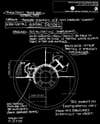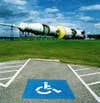It Doesn’t Take a Rocket Scientist
Space architect Constance Adams spent seven years at NASA. Here's her prescription for fixing the place.
Good news/bad news: The Columbia disaster has brought renewed attention to spaceflight, but so far, much of that attention lacks any real clarity of understanding. Rather than train the spotlight on our space program’s fairly desperate need for both funding and vision, Columbia seems to have ushered in open season on NASA. Congressional hearings rehash hoary old debates about the value of our space program, chastizing the agency and calling for hastily conceived reforms. Many people with whom I’ve been privileged to work closely inside and around NASA share my concern that we may be on the verge of making irreversible decisions that future generations will regret. The Bush administration’s announcement of a redirection of the space program, which was pending at press time, may address some issues raised by the Columbia investigation, but it’s sure to miss some more fundamental problems, problems that are deep, structural and, if you believe in the value of space exploration, critical to our place in the 21st century.
THE “KNOWLEDGE CAPTURE” PROBLEM
In a decade of professional practice in large-scale urban, medical and institutional architecture, I have always started any new project with an investigation into institutional memory. I need to know how previous programs arrived at their final designs before I feel qualified to propose next-generation solutions. But almost immediately after I arrived at NASA in 1997, I learned that trying to gather such information in the 18,000-employee, 16-facility agency was tough going. The standard response when I requested data on old projects was a quizzical stare. As I began working on the design of the TransHab, an inflatable habitat for long crew expeditions like a Mars mission, I realized I needed solid dimensions for Skylab interiors and furnishings. Those drawings always seemed archived somewhere beyond reach. Eventually I just went over to the Skylab 1G Trainer at Space Center Houston’s visitor center with a tape measure and some gum-soled shoes. I’m sure it gave a few tourists a real thrill to come into the Trainer exhibit and find me dangling from the ceiling.
In its collective knowledge and in the individual history and experience of its employees, NASA is a unique, living national treasure of know-how. But the know-how is frustratingly hard to access. Think of NASA as a computer with
virtually no interface and rusty hard drives. Furthermore, its storage media are getting old: The only American men and women who have ever successfully designed and flown a spacecraft are retired or retiring; many others are no longer with us. Without a conscious program of mentoring within the organization, this knowledge is only intermittently and imperfectly transmitted to new generations of engineers and scientists. The result is that young engineers constantly redesign programs without being aware that previous designs for the same item already exist. They may thereby introduce a new problem or layer of risk, and this gets to the
heart of the matter: As has been pointed out with regard to the Columbia disaster, there is within NASA a creeping lack of interest in real expertise. When any bureaucracy supports its mandarin culture over real intellectual capital–precisely what the board that investigated the Columbia disaster accused NASA of doing–it becomes stagnant rather than productive.
What NASA needs to do is establish an active mentoring program, whereby new hires are apprenticed to senior technical staff for a certain period of time; allow real engineers (not a recruiting team) to select graduate students for internships; and open a direct line between each project office and the central archives so that records of a team’s decision-
making process and detailed information on the final
product are readily available.
But even these measures won’t fully address the squandering of hard-won expertise, because the problem isn’t confined to a failure of archiving. Any team that takes on a project is going to amass some truly valuable information. What happens then? At NASA, more often than not, project teams get disbanded and people with unique knowledge get poached away. Whereas other industries actively encourage the capture of knowledge in team environments–where the sum of knowledge is measurably greater than any individual effort–NASA seems unaware of the value of a stable, successful team and its ability to store, transmit, and use accumulated knowledge.
Our TransHab project team was ultimately able to get far enough in our testing and design to warrant what NASA calls an Independent Technical Assessment. In our case, this meant that NASA invited some of the old guard (including Charlie Feltz, chief engineer of the X-15; Chris Kraft, Mission Control pioneer and former Johnson Space Center director; George Jeffs, chief engineer on the space shuttle; and Johnson Space Center director George Abbey) to come out of retirement for a few days and formally assess the project. Such events seem relatively rare, yet in their intensity, methods and relentless pace, they hearken back to the early days of human spaceflight. The panel picked apart our reasoning and process just as surely as they tackled the technologies we had developed, and in so doing taught us how they themselves had pulled off
the feats that made NASA great. Finally earning their approval after three days of vigorous work felt like the greatest achievement of my life.
Our final task, a six-week feasibility study on a different vehicle, was particularly exhilarating. By then we had absorbed all the questions and critiques from our advisers, and we started using their assessment tactics on one another. Now able to anticipate how our teammates would work, we came up with solutions that produced a truly elegant spacecraft.
And then we were disbanded. The dissolution of a project team that could produce a vehicle like TransHab on a shoestring budget is a great loss to the space program, not necessarily because any one of us is particularly special but because the team’s accumulated knowledge represented nearly
40 years of spaceflight, the results of thousands of failures large and small. As Charlie Feltz told us, “engineers learn by failures. We’ve had a lot of failures.”
Here’s an idea: Why don’t we borrow a pattern from design disciplines like architecture and industrial design, and develop “studios” populated by specialists from different fields–and when one project is done, try keeping the team together.
THE “VISION CAPTURE” PROBLEM
NASA has a bigger problem than the knowledge-capture failure noted above: It has an institutionalized inability to capture vision. Post-Columbia, more Americans than ever have sensed this. “The space shuttle is unsafe, and we should stop flying it now,” they say. “Why hasn’t NASA developed anything to replace it?” It’s a question that insiders ask as well. Most folks I’ve talked with in advanced engineering at NASA agree that the United States should have started building a next-generation shuttle in the mid-1990s, when Columbia and Discovery, the oldest shuttles, had reached their 10-year minimum life span. Max Faget, the chief engineer on the Mercury, Gemini and Apollo capsules, told the press last spring that it’s a shame we haven’t built a new spacecraft. With today’s technologies and materials, we could make something much lighter and cheaper to fly and maintain than the shuttle.
It’s not that NASA hasn’t taken first steps toward developing a meaningful shuttle replacement–it’s just that those steps invariably ended in a stumble. In the past three years, we’ve seen three separate programs proposed: the Second Generation Reusable Launch Vehicle (2GRLV), the Space Transportation Architecture Study (STAS) and the Space Launch Initiative (SLI). Each set forth overarching new strategies and architectures for human spaceflight that differed only slightly in scope. And each took a few toddling steps before the rug was pulled out. (Just three months before the Columbia accident, NASA diverted the SLI’s $4.5 billion budget to help cover the needs of the shuttle and International Space Station programs.)
Now NASA is pushing a new program dubbed the Orbital Space Plane, which is widely touted as the plan to replace the space shuttle. There is some confusion in this, since not one of the specifications of the Orbital Space Plane as currently envisioned could match the shuttle’s capacity for crew support, nor its sheer power as a high-tonnage launch system.
To be sure, the OSP’s requirements have descended directly from aspects of the three major initiatives mentioned above. But the OSP inherited just three components–for crew return, crew transfer, crew rescue–from complex systems that included launch platforms, light- and heavy-lift capabilities, vehicles for science payloads, cargo and exploration support, as well as the more ordinary, everyday support features for the ISS and its crew.
The inherited crew-transfer component had originally been conceived as one element of a broad, upgradable, long-term system, capable of carrying up to 10 passengers for full-up missions, and of active docking and orbital operations. As the OSP emerged last spring, it had fewer and fewer of those characteristics, until it became the pint-size version of a passive-crew-rescue vehicle envisioned today. A competition that was already under way–and from which several potential bidders had been eliminated–had been radically rescoped to meet immediate political goals within soaring budgetary shortfalls.
Why? Probably because there wasn’t enough vision or commitment behind the shuttle-replacement plans to begin with.
What should have happened? NASA should have continued to develop the architecture for a true shuttle-replacement
system and requested that the crew-transfer part of the program be fast-tracked; or, if that approach didn’t seem responsive enough to the needs of the day, the table should have been swept clean and the process started afresh with a new set of problems on the boards.
One result of the retrofitting rush that gave us the OSP initiative is that the smaller, more risk-taking and often more dynamic companies were knocked out of the bidding before it even got going. Now that the OSP only need accommodate four people and ride atop an expendable, commercial launcher, it’s beginning to look to me an awful lot like the various vehicles being developed by the contenders for the X Prize. Yet by the nature of the bidding, none of those 25 teams has any chance of bringing its space-plane concepts to OSP. What would be the result if NASA were to enable this sharing of
ideas by inviting competition and reopening the field of design solutions? Most likely cost savings and superior design.
Here is the recent history of shuttle-replacement systems in a nutshell: Propose and study a succession of systems, then fight to keep a single subcomponent going when the budget is slashed–without considering its long-term compatibility with the rest of the human spaceflight program. All these separate pieces somehow need to be made to fit the next wave of big-picture plans. And the Big Plan bogey keeps shifting–it’s anyone’s guess how the OSP will fit into the Bush Administration’s new space initiative. When the components’ utility in a new scenario is hard to prove, they get shot down–no matter how much effort has already gone into their development. They become ideas that go back on the shelf, only to get reinvented by future generations.
THE “GREAT PROJECTS” PROBLEM
As many wise space pundits have said in recent times, NASA needs a challenge. Without a broad, external challenge backed up by consistent support and political will, it seems unlikely that the kind of heroic effort and vision that characterized the first decade and a half of NASA’s existence will re-emerge.
What these pundits are really bemoaning is the lack of consistent vision, which ultimately stems from an issue that is much larger and older than NASA, and whose nature is of profound interest to architects and master planners, because it has a powerful effect on the kind and scale of projects we may build. Simply put, undertaking what we call Great Projects–projects of a large, public scope whose completion will require 10 years or more–is very difficult in a democracy.
In an autocratic society, it is common for rulers to make their mark by commissioning massive works such as roads, fortifications, elaborate religious or magisterial structures. And once the order has been given, it becomes a goal of the government to see that the works are completed, and in such a way that they stand to the glory of the rulers who brought them into being.
Under our democratic system, it is inherently impossible to ensure that any long-term program will receive funding, or remain consistently funded, from year to year. From this perspective, the four terms of FDR’s nearly unchallenged administration may well have been critical not only to the establishment of the Works Progress Administration but, more important, to the completion of many individual WPA projects.
Certainly in today’s politically polarized environment, a shift from a Democratic to a Republican administration (or vice versa) often portends the cancellation of many unfinished public projects–for example, the several major human spaceflight programs axed before the end of February 2001, less than a month after George W. Bush’s inauguration.
When budgets are cut, the public needs to be aware that this will result in the loss of valuable programs and personnel. But for those losses to matter to the American people, a truly inspiring vision for NASA must be articulated. And when politicians announce new NASA initiatives, whether to the Moon or Mars or beyond, the public must listen hard within the announcement for a coherent plan and a powerful commitment–including, of course, the funding–to deliver the mission itself and not just the idea of mission.
On this point, the Columbia Accident Investigation Board’s report is very clear: “It is the view of the Board that the previous attempts to develop a replacement vehicle for the aging Shuttle represent a failure of national leadership.”
NASA proved a long time ago that it can answer a profound and improbable challenge, as it did with the great Moon mission announced by President Kennedy in 1961. But it is not up to NASA to supply the vision itself. That falls to our leaders. If they do supply the vision, it’s a safe bet that a truly renewed NASA will do an extraordinary job of bringing it to fruition.

by NASA

Adams’s Critique

Pre-existing Design

Outsider In

by Brent Humphreys